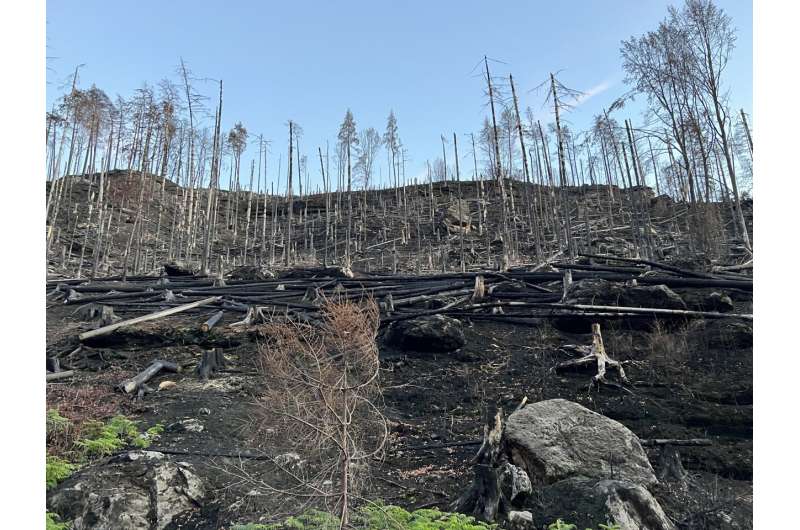
A team of researchers from the Senckenberg Biodiversity and Climate Research Center Frankfurt (SBiK-F) and from partner organizations of the joint EU project “FirEUrisk” has investigated the development of forest fire risk in Europe in the coming decades and identified worrying trends.
Their study, led by Senckenberg scientist Prof. Dr. Thomas Hickler and published in the scientific journal Environmental Research Letters, uses high-resolution climate models to show that the risk of fire will increase significantly throughout Europe. The higher the level of global warming, the more dramatic the “fire weather” will become, say the scientists.
Even in areas of Central Europe that were previously at moderate risk and in rapidly warming mountain regions, dangerous weather conditions will occur with increasing frequency; the researchers therefore emphasize the growing importance of prevention and control measures.
In the past 10 years, the climate in Europe has been hotter and drier than at any time in recorded weather history—resulting in a higher fire risk than ever before. In 2017, almost 1 million hectares of land burned on the European continent. A particularly high number of fires broke out in the Mediterranean region, which has always been subject to severe forest fires, and even areas not previously considered at risk of burning, such as the United Kingdom, were affected by fires.
A European research team used data from various high-resolution climate models to investigate the expected development of the risk and frequency of such fires as climate change continues to advance in Europe.
“Our data show that this dangerous trend will continue in the coming decades and that the risk of forest fires will further increase throughout Europe—even with a significant reduction in greenhouse gas emissions,” explains the study’s first author, Jessica Hetzer from the Senckenberg Biodiversity and Climate Research Center Frankfurt (SBiK-F).
“Even in our calculated scenario with the lowest CO2 increase, the average weather-related forest fire risk in the summer in Europe will increase by 24% by 2050, compared to the historical average. With high greenhouse gas emissions, this increase will be even more drastic. At the same time, an increasing number of regions will be affected.”
In order to measure the intensity of so-called “fire weather”—i.e., the combination of risk factors such as high temperatures, low humidity, and low precipitation, combined with frequently strong winds—the researchers used the Canadian Fire Weather Index (FWI), among other things, and calculated different scenarios for the period up to 2080.
“In the already fire-prone regions of southern Europe—countries such as Greece, Cyprus, Spain, Portugal, Croatia, and Turkey—conditions will become even more extreme,” says the study’s leader, Prof. Dr. Thomas Hickler (SBiK-F). “For the ecosystems and societies of these countries, this frequent extreme fire weather is a major challenge.
“At the same time, areas in Central Europe, parts of Northern Europe, and especially the rapidly warming mountain regions will be threatened by severe fires. If CO2 levels rise sharply, fire weather in the German low mountain ranges, the Carpathians, the Vosges, and the Massif Central could increase by up to 60% in certain areas.”
The increasing frequency of fire weather in mountainous regions poses additional risks. “The fire danger is also influenced by factors such as the nature of the terrain and the flammability of the vegetation,” explains Senckenberg researcher Dr. Matthew Forrest. “Complex topography and steep slopes can significantly increase the risk of fire.
“For one, fire can spread more quickly in areas that are difficult to access and overgrown with brush due to limited cultivation; at the same time, it is more difficult to fight fires in rough terrain. In these regions, vegetation and inhabited areas often intermingle. This creates a considerable risk of fires in settlements and of heavy smoke pollution.”
The researchers therefore emphasize the increasing importance of early warning systems, fire monitoring, and firefighting, even in previously less affected regions. According to the study, early attention to the increasing risk situation could be key to averting future disasters before they occur.
“In Central Europe, the management of forest fires has been a low priority to date. As a result, some communities are not adequately prepared for longer periods with a high fire risk. We urgently need short-term ‘fire-aware’ decisions in urban planning, forestry, and land management to protect both the forest and its neighboring communities,” explains Hetzer.
“Increasingly extreme fire weather does not necessarily mean more fires. We can adapt to this, at least to a certain extent, but it is difficult to predict at which point the threshold will be exceeded,” Hickler summarizes.
More information:
Jessica Hetzer et al, The fire weather in Europe: large-scale trends towards higher danger, Environmental Research Letters (2024). DOI: 10.1088/1748-9326/ad5b09
Citation:
Europe’s trial by fire: Risk of forest fires continues to rise (2024, July 30)
retrieved 30 July 2024
from https://phys.org/news/2024-07-europe-trial-forest.html
This document is subject to copyright. Apart from any fair dealing for the purpose of private study or research, no
part may be reproduced without the written permission. The content is provided for information purposes only.
